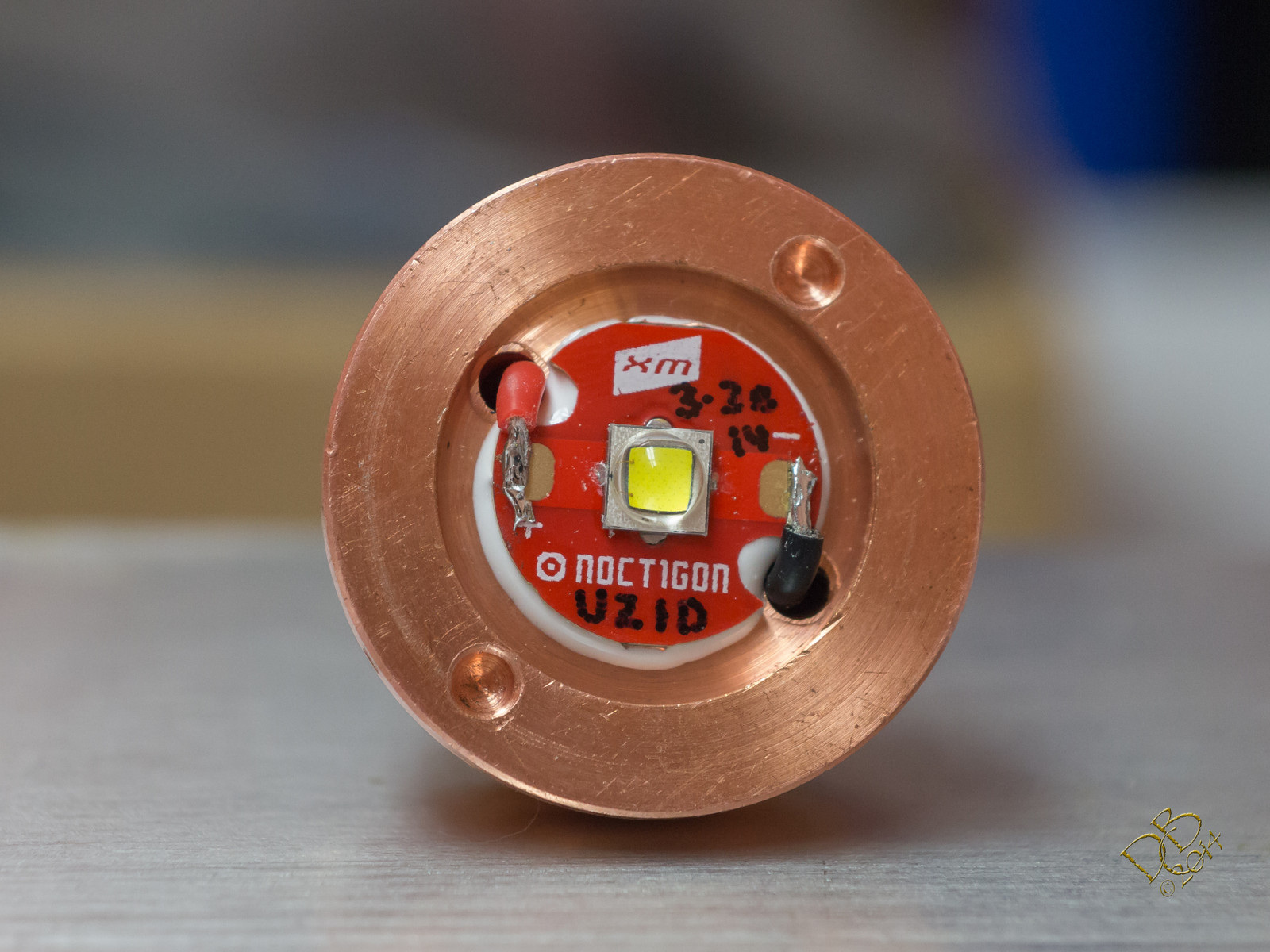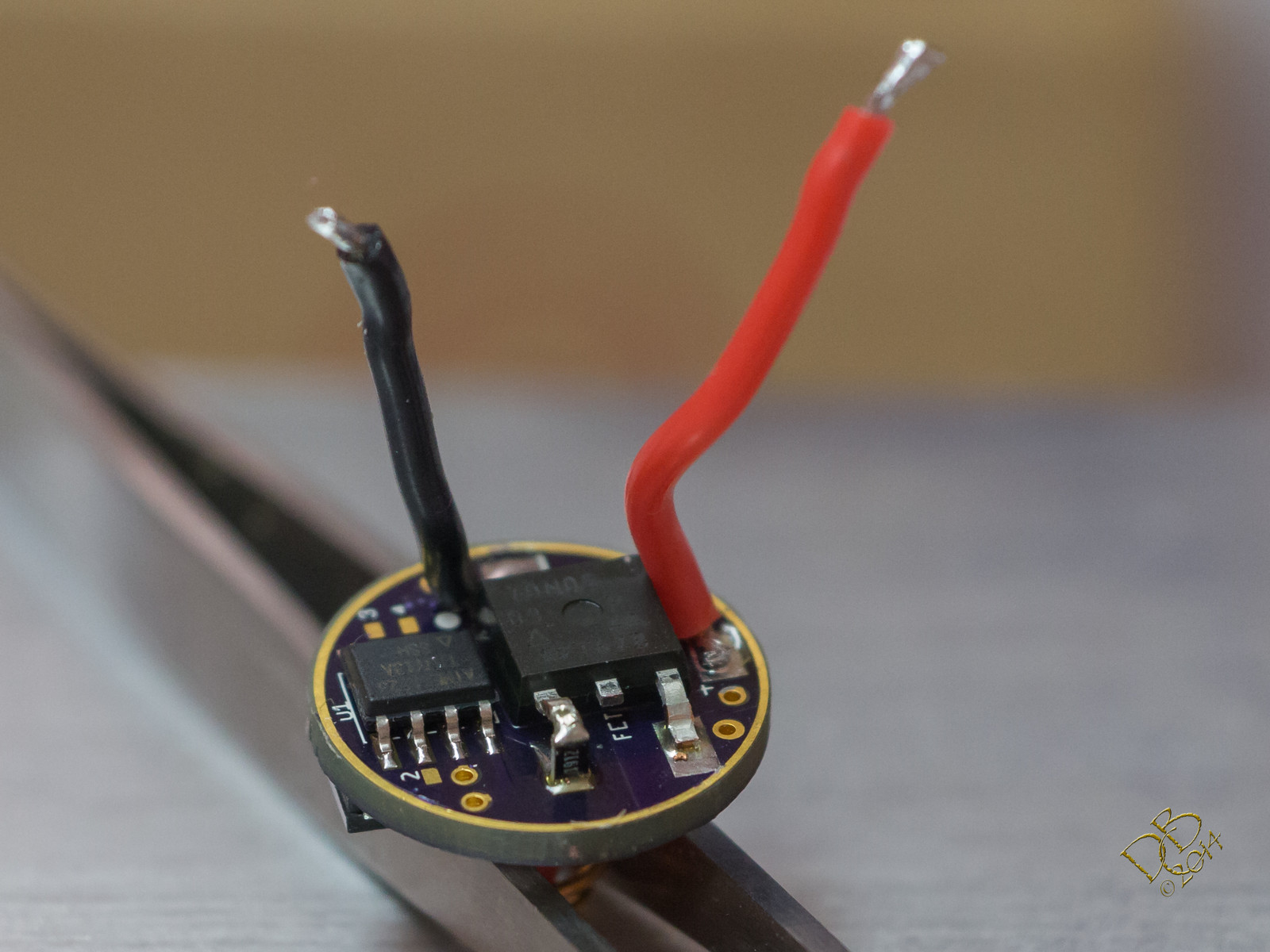Not as a sidetrack…see if you can invite this guy over to join in the fun
On the SRK version... minimo (phase correct) works fine, but is noisy, as it has been on any of the drivers I've used it on. But STAR v1.0 works on it too, and I think (though not sure) it's set to use fast-PWM as-is, and I didn't change anything in the code except to plug in my own PWM values.
On the 17DD, luxdrv didn't work right before the two resistors were added. STAR v1.1 did work, but again I'm not sure which PWM version it's using as the default. After adding the resistors, it worked with the other DrJones fast-PWM firmwares, which none of the other boards using the FET have been able to do.
I even took the same build of minimo that worked on the SRK driver, and flashed it to the 17DD (before adding the resistors - and remember, the SRK board doesn't have those two extra resistors, and yet it works fine), and it didn't work. It did the same goofy halfway or double mode changes. So, same parts, same firmware, different PCBs, one worked and one didn't.
Or you could just ask me .
.
Yes that's nxp lfpak 5x6mm. Many other manufacturers have similar 5x6mm power packs=power soic.Nxp lfpak is interesting because of exposed drain pad,so no need for extra pad on pcb for cathode led wire(of course this isn't the only reason why I chose nxp mosfet,many other parameters are important).
The biggest difference between lfpak and old packing technologies like dpak,d2pak etc. is lack of bonding wires,which means much better characteristics.

That's all wonderful, but are the olde-timey FETs prone to failure in a design like a 4.2v max flashlight driver circuit? A motor controller for an electric/hybrid car, sure, that's a highly stressed and critical application. But that's a long ways from a flashlight. If the driver gets up to 150*C, you got bigger problems to solve first.
Per compile
define F_CPU 4800000 CPU: 4.8MHz PWM: 9.4kHz ####### use low fuse: 0x75 #######
Did you compile luxdrv at 9600000
define F_CPU 9600000 CPU: 9.6MHz PWM: 19kHz ####### use low fuse: 0x7a #######
OOPS…I stand corrected
bove PWM speeds are for phase-correct PWM. This program uses Fast-PWM, which when the CPU is 4.8MHz will be 18.75 kHz
Nice to see you led4power. I actually like poking around the web so I don’t often ask unless time is critical or I just can’t find something. I learn more this way. I had actually first seen that FET before you posted your driver thread and it totally made sense to take advantage of its capabilities the way you have. Definitely subscribed to that one by the way. Comfychair I have loads of 7135’s but I’d use something else if it worked better. You seem set against trying another chip more for personal reasons than performance based ones and there’s nothing wrong with that but the Dpak doesn’t fit on anything smaller than a 17 mm board and that not well. I’m not saying we not use the older style FET at all, just that we keep our eyes open. Both Werner and tivo532 had to resort to multiple small fets which introduced yet other issues because of inadequate power handling capabilities and this new style may eliminate that problem. As to the temp rating, having excessive overhead is better than having none. There may certainly be other small FET’s out there with current capacities somewhere between 5A and 70A and I’d be fine with one of them(the 56 is rated for 100A), I just didn’t see one.
I put this one together like I knew what I was doing, it went together nice and neat, including the resistor under the PWM gate…all re-flowed nice and pretty. Everything went in place nicely on the back as well. I sized the board to be a tight press fit into one of Ryan’s big copper pills for the HD2010. Snapped it in, inside outer ground ring is making ground, soldered the XM-L2 U2 1D on the 16mm Noctigon (glued in with AA) and it works. Mostly.
No moon engaged. There are 2 modes, Lo and Turbo. Lo is at .25A and then it goes to Turbo at 5.8A. How in the world have I lost Med and High?
In MiniMo, change TCCR0A=0b00100001; to TCCR0A=0b00100011; for fast PWM (18kHz).
Note that a PWM value of 0 doesn't switch off in fast PWM mode.
Thanks! I'll figure this out, eventually...
The LEDs don't turn off, but that's fast PWM when using 7135s, the FETs react differently at the very low end. But does the MCU shut down like it's supposed to? I haven't had time to experiment yet and check any of that, I guess measuring parasitic drain between phase correct & fast PWM versions (assuming the LEDs turn off) would answer that.
I do know that with the phase correct code it used to work with a value of 1, but after adding the gate resistor it no longer turns the FET on unless that minimum is raised to 2. With the same code the 7135s don't start working until 4 or 5.
If there was a performance difference between LFPAK & DPAK parts in this application the same as what there is between DPAK & 7135s, then we wouldn't be having this conversation and never would have bothered with designs using the DPAK parts...
I'm not opposed to changing anything ever for any reason, but I am opposed to changing things that end up only making it theoretically better on paper but don't show any difference in actual use. If they're both similar cost then that's a wash, the performance is similar since once you get down into the sub-10mOhms range there's just not much improvement to be had so that's basically a wash too, yes they are smaller so the board design gets easier so that's a real tangible benefit, and then the durability issue is a wash as well since neither design is highly stressed enough to show any vulnerability to failure.
The LFPAK devices require proper surface mount equipment to attach them to the board correctly… solder paste stencil, reflow oven, etc. And good luck getting them off if you need to…
Other than the small detail that it doesn’t fit on a 15mm board. I’m in no way suggesting we abandone using the dpak but that since it won’t work for all our needs that we look around for other options that will work in those instances.
FWIW, I finally discovered my error in the 17mm DD board. I don’t know electronics. I didn’t know the coding for resistors. Without that knowledge, a 1912 marking looked essentially just a little bit less than a 2000 marking. So I was using the wrong resistor by a long shot for the PWM gate. Fixing that, it works just fine.
For anyone following this that, like me, doesn’t know these things…the 4 digit identification has the 4th digit as a multiplier of 10. Such that 2000 is 200 to the zero power or simply 200. 1912 is 191 to the 10th power, or 19,100. Vastly different although the number itself looks so similar. And that, in a nutshell, is why messed up my second and third attempt at building this driver.
Pulled the 1912 resistor and put the proper 2000 resistor in place and it works just fine. ![]() (This is between the PWM leg of the FET and the pad to the MCU. This was added as a buffer to protect the high current on/off from killing the MCU)
(This is between the PWM leg of the FET and the pad to the MCU. This was added as a buffer to protect the high current on/off from killing the MCU)
2000 is still way too high, should be around 100-150 ohms on the one between MCU & gate.
The other one that goes between the gate & ground is there to provide a path for any leftover signal to drain away when the MCU turns off the PWM output, supposedly otherwise there can be a bit of charge trapped in the line and can keep the FET on when it shouldn't be.That one should be high, over 10,000, or else too much of the MCU's output can leak away and not go to the FET where it's needed.
Here's a cheat sheet for SMD resistor markings: http://www.hobby-hour.com/electronics/smdcalc.php
Believe it or not, when I found out I was using the wrong resistor I actually did research the identification codings for resistors. And realized I’ve seen all that before when modding my S2200 some time back. I can forget as easily as y’all blink your eyes. ![]() This is due to medical issues that have plagued me for going on 14 years. Such is life.
This is due to medical issues that have plagued me for going on 14 years. Such is life.
I’d never remember how to work a smart phone. Simple flip phone for me. You should see my trying to keep up with my Canon 1DsMkII. ![]()
The final success story…waiting now for the FandyFire HD2010 from the O-L group buy…
The above pic shows the wrong resistor, but it’s been swapped and is working perfectly now.
Nice tint, should have pretty good lumens output as the Efest 35A shows around 5.8A on Turbo. I’ll need to grab a couple of Sony 50A 26650’s and test em out here…
So that resistor helps with the mode selection using luxdrv?
and 5.8A…whoah!
Nice copper pill Dale. 
Are you leaving the dome on?


